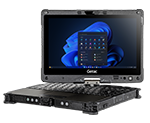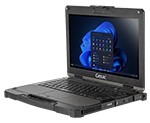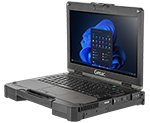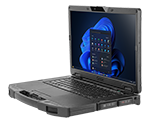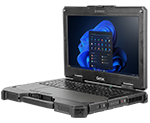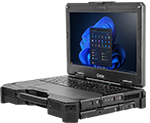A lack of real-time information and breaks within the supply chain management process negatively impact last-mile logistics and supply chain efficiency. Allowing for complete connectivity and clear communication, rugged mobile technology repairs the breakdown within supply chain management (SCM) and transportation planning.
The world’s supply chain is under increasing pressure to become more efficient and at faster speeds, while customers demand information and speed. Such pressures are complicating last-mile transportation and logistics and straining business effectiveness.
With e-commerce increasing worldwide—Adobe expects the global sales numbers to hit $4.2 trillion in 2021—the strain on last-mile logistics is only going to worsen. Inadequate planning, poor visibility into last-mile processes, and poor communication are just a few of the many problems that transportation and logistics companies must deal with. Fortunately, mobility, through rugged devices, complements effective last-mile technology and can solve these supply chain efficiency challenges.
Here are the top five last-mile problems within the shipping and logistics industry that affects supply chain efficiency and that mobile devices can help solve:
Increasing demands for better customer service
One-day shipping. Real-time alerts. Customers’ concept of good customer service has been setting the bar high over the last few years. Equally important, customers want the information in a mode that is easily accessible to them, whether that is through a text or email or chat. The age of omnichannel buying and multichannel service is here, which means transport and logistics companies need to integrate the customers more fully into their processes and develop an efficient supply chain.
Customers want real-time information and last-mile delivery software, with orchestrated methods, can keep customers fully in the loop. Customers can receive texts about expected delivery windows, reschedule deliveries, and communicate last-minute changes as needed. Drivers and delivery personnel can use their mobile devices to work with data, uploaded with fleet telematics and last-mile delivery software, to relay information. In most cases, simply updating a few fields and live tracking through GPS is enough to trigger communications, which saves an extra step for the delivery personnel. Such efforts help increase customer satisfaction and supply chain efficiency.
Poor visibility
One of the biggest challenges in a supply chain is not knowing where the materials or products are. Pen and paper processes lead to poor inventory management, limited visibility, and poor tracking of goods, which makes it difficult to plan processes down the line. In such a landscape, the question of how to improve supply chain processes becomes key to maintaining a competitive advantage. Mobile devices help store, relay, and track information about every item in every part of the world. All the information can be readily available from one central database which is updated by stakeholders in real time.
Mobile devices enable all transportation and logistics providers to work with a central source of information that is easily available. Such transparency also helps all affected parties make data-driven decisions instead of having to operate with inaccurate information. Mobile devices are a critical component of the digital transformation of the supply chain into digital supply networks. In a field driven by data, their contributions are priceless.
Frequent returns
With rising shipping costs, companies are looking for ways to prevent returns, especially as very often, they are also expected to bear the brunt of the return package shipping costs. Mobile devices help in cutting down returns. First, the last-mile provider can use the camera functionality on the mobile device to take a picture of the package delivered so that its condition can be recorded with the bill of sale and other information. Second, last-mile delivery software on the mobile device gives proof of delivery, which can help resolve customer disputes, if any.
Delivery personnel can also help set up equipment as requested and record relevant information on the mobile device that can document problems or attend to a checklist of processes that need to be completed to consider the sale and delivery complete. By ensuring goods are in the best condition and set up to be used in the right way, mobile devices help with a key aspect of last-mile transportation and logistics and boost supply chain efficiency.
Inefficient routes
Unexpected events can happen at any time, adversely affecting supply chain efficiency. Whether such events are long traffic delays or problems caused by weather, transportation and logistics companies need to be able to adjust their delivery routes in real time. Not having an effective way of communicating with dispatch or a clear overall picture of the changing situation on the ground, makes last-mile logistics less efficient.
Through a rugged mobile device on a vehicle dashboard, delivery personnel can communicate problems on routes, help attend to additional jobs en route to warehouses and improve route optimization and supply chain efficiency. Such last-mile technologies save time and money and in turn also improve customer satisfaction.
Complicated warehouse inventory management
Efficient last-mile delivery begins at the warehouse. Today’s retail and supplies landscape has led to warehouses large and small, all of which demand precision packing and tracking of inventory and software. Micro-fulfillment centers are also increasing to cater to customer demand for speedy shipping. The complicated inventory management that must now be stretched between large warehouses, micro-fulfillment centers and inbound and outbound freight all demand strong orchestration of real-time information about inventory.
Rugged mobile devices in the warehouse ensure efficient workflows and accurate record-keeping, which ensures supply chain efficiency and smoother transportation and logistics operations down the line.
The transportation and logistics industries are facing many challenges as the global supply chain gets tested on the one hand, while customer demands keep increasing on the other. Digital transformation and technologies such as robotics and advanced last-mile software can help with supply chain improvement. Mobile devices are the platform to access such help and real-time information.
Contact Getac to learn more about how our rugged mobile solutions can help you make supply chain management more efficient.

